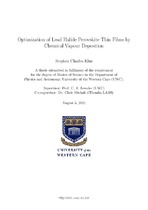| dc.contributor.advisor | Arendse, J. | |
| dc.contributor.author | Klue, Stephen Charles | |
| dc.date.accessioned | 2021-08-16T08:03:57Z | |
| dc.date.available | 2021-08-16T08:03:57Z | |
| dc.date.issued | 2021 | |
| dc.identifier.uri | http://hdl.handle.net/11394/8328 | |
| dc.description | >Magister Scientiae - MSc | en_US |
| dc.description.abstract | Perovskite solar cells have gained tremendous attention within the past
decade, due to its rapid improvement in power conversion e ciency (PCE),
with the current record cell at 25%. The aim of this study is to create a
repeatable and scalable chemical vapour deposition technique that can be
used to construct perovskite solar cells with a high PCE while maintaining
long-term stability. The technique requires the formation of a uniform and
compact lead halide layer, either PbI2 or PbCl2 that is sequentially converted
into the perovskite structure with the exposure of Methylammonium
iodide (MAI) vapour. The use of CVD with a 5 cm diameter quartz tube
was successfully used to deposit uniform thin lms of both PbI2 and PbCl2
over an area of 6 cm2 with a thickness deviation of 5%. Thickness control
was obtained by varying the amount of source material which allows for
repeatable control within 5% error, without the need for a crystal thickness
monitor. | en_US |
| dc.language.iso | en | en_US |
| dc.publisher | University of Western Cape | en_US |
| dc.subject | Perovskite solar cells | en_US |
| dc.subject | Chemical vapour deposition | en_US |
| dc.subject | Halide layer | en_US |
| dc.subject | Thin films | en_US |
| dc.title | Optimization of lead halide perovskite thin films by chemical vapour deposition | en_US |
| dc.rights.holder | University of Western Cape | en_US |

